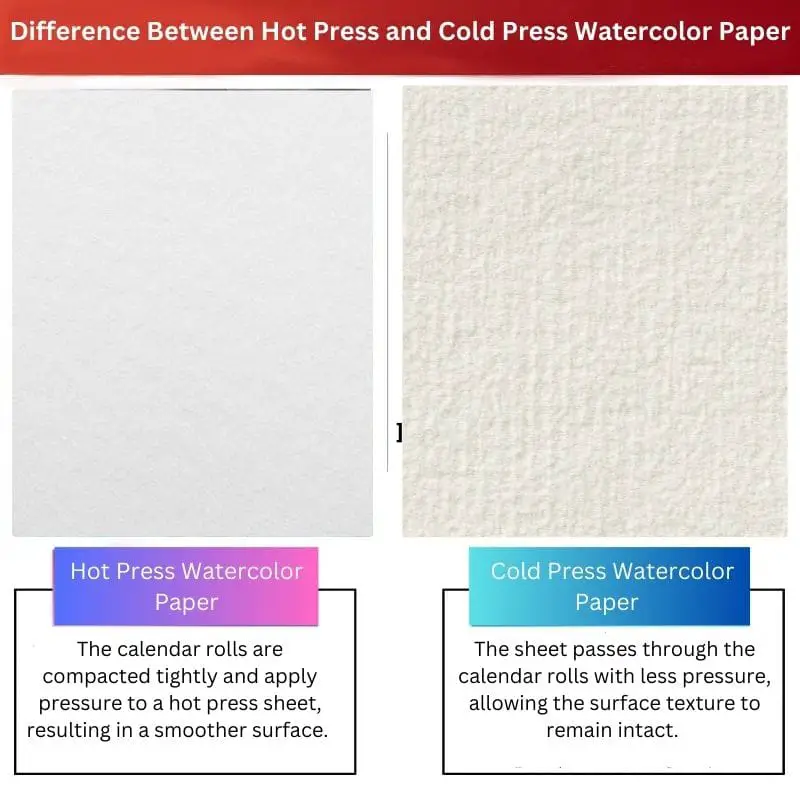When it comes to choosing a paper to work with, artists have a lot of options, brands, and quality levels to consider. There are other textural options for watercolor artists to consider.
Watercolor paper manufacturers simplify the process by labelling watercolor textures as “hot press” or “cold press.”
Key Takeaways
- Hot-press watercolor paper has a smoother texture than cold-press watercolor paper.
- Cold-press watercolor paper has a more textured surface than hot-press watercolor paper.
- Hot-press watercolor paper is suitable for detailed artwork, whereas cold-press watercolor paper is ideal for creating a range of textures.
Hot Press vs Cold Press Watercolor Paper
Hot Press watercolor paper has a smooth surface texture that is created by pressing the paper fibres between hot metal rollers during the paper-making process. Cold-press watercolor paper has a more textured surface that is created by leaving the paper fibres relatively uncompressed during the paper-making process.

The method of production for this sort of watercolor paper is known as “hot press.” The sheets are traditionally pressed under high pressure between smooth, heated rollers in this process, hence the term “hot-pressed.
This method also contributes to the paper’s flawless surface quality.
A rough texture can be seen on cold-press watercolor paper. Water and pigment are held in place by a series of little bumps and grooves.
The water is soon sucked up. If you want to express texture in your subject, a cold press is an excellent option. The washes and layers are less defined on a cold press sheet.
Comparison Table
| Parameters of Comparison | Hot Press Watercolor Paper | Cold Press Watercolor Paper |
|---|---|---|
| Texture | Super smooth texture. | Uneven and bumpy texture. |
| Papermaking process | The calendar rolls are compacted tightly and apply pressure to a hot press sheet, resulting in a smoother surface. | The sheet passes through the calendar rolls with less pressure, allowing the surface texture to remain intact. |
| Watercolor absorption | Less absorbent | Very much absorbent |
| Color quality | Colors look brighter and vivid on hot press paper. | Colors look pale and less rich than hot press paper. |
| Ease of use | Preferred by the artists, shows a higher level of skills and brush details. | Easy to use, suitable for beginners. |
What is Hot Press Watercolor Paper?
The smooth mover’ of the group is the hot press. This paper’s lack of texture makes it ideal for tighter, more realistic paintings and illustrations, resulting in a much more polished final product.
Made by being pressed by hot metal, the smooth surface allows for an effortless flow of pigment, which is perfect for even blends (like iron).
It’s ideal if you like painting intricate topics, such as botanical paintings and portraits. The texture is the least absorbing. Because the hot press is the least absorbent, it takes the longest to dry.
Hotpress paper is run through heated rollers, resulting in an extremely smooth texture that interacts differently with watercolor paint, allowing it to have more “slip” and “open time.”
They are less absorbent than cold press papers and are perfect for artworks that require flawless mixing.
It is pretty expensive, but the quality is excellent. The expense of the ingredients used and the time it takes to make the top-quality watercolor paper are the key reasons for its high price. Cotton is used to make the highest quality watercolor paper.

What is Cold Press Watercolor Paper?
Cold press offers excellent absorbency while yet allowing you to deal with the pigments while they are still wet.
This is the most popular choice among watercolor artists since it is the most versatile and adapts to a wide range of painting techniques. Cold metal was used to press the design.
This is the most popular among watercolor artists since it absorbs a lot of water and keeps the color bright after drying. The most popular paper type is the cold press.
It is left with a ‘tooth,’ a slightly rough surface that will hold color as it passes through the rollers.
Cold press papers have a lumpy, uneven texture that adds to the overall beauty of the drawing.
This is because the indentations of the rough, uneven surface of this paper scatter the light reflected on it, resulting in a combination of soft colors that make the overall piece look lovely.
Cold press papers are more popular and easier to use than hot press papers. Even novices and amateurs can easily utilize watercolors on cold press papers; practising and completing your first watercolor projects on cold press paper is simple.

Main Differences Between Hot Press and Cold Press Watercolor Paper
- The cold-pressed paper has a slightly bumpy, textured surface. On the other hand, the hot-pressed paper has a smooth surface finish.
- Cold press paper is more absorbent than hot press.
- Calender rolls are tightly compressed throughout the papermaking process, adding pressure to a hot press sheet and resulting in a smoother surface. On the other hand, the sheet travels through the calendar rolls at lower pressure for cold press surfaces, preserving the surface texture.
- On cold press paper, the colors come out a little less rich when the same color looks extremely vivid and brighter on hot press paper.
- Cold press paper is more popular than hot press. One can use any kind of watercolor on this type of paper. Hotpress is popular among artists.




